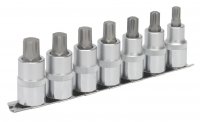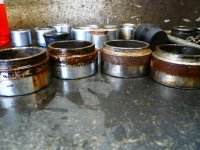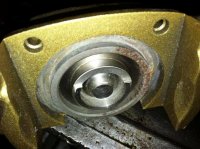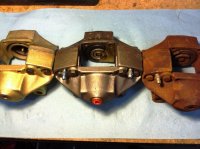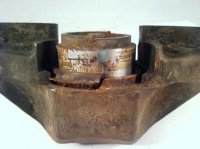Zinc Plating
Next I'm going to get on my ole soapbox...
Zinc Plating
Next up in our preparation section we’ll address the major problem with all calipers needing a rebuild and all home-grown and big-box calipers that have been rebuilt. This is extremely important. 99.9999% of all caliper failures is caused by rust… (Read these next words very carefully as it is the most important part of a caliper rebuild)
“Rust Inside the bore”.
Calipers fail because of rust build up inside the bore. Brake fluid is hygroscopic. That means it attracts water. You system is open (note the small holes on the top of the fluid reservoir cap). If you do not change your brake fluid regularly, water will work its way into your system and, it likes to gather around the rubber seals. As it gathers, it mixes with old brake fluid and, it creates a shellac-like component that causes the piston to stick. Left alone for very long and it will actually rust through the pistons hard nickel coating and you’ll need new pistons. ATE does a great job plating pistons (with the exception of their S-Caliper pistons which show up on early Porsches and some Alfa factory race team cars).
There are a couple more areas and issues that will cause rust to form inside the caliper. It’s time to expose some Internet myths:
1. “Hone the caliper bores.” This is incorrect. DO NOT hone the caliper bores. They “do” make brake hones. For the life of me, I’m trying to think of one thing you would want to “hone” in a bore. It’s not like caliper bores grow sharp fangs over the years. Rust is about the only thing that can cause a bore to need to be honed however, if you have rust in your bores, you don’t want to hone it and leave the surrounding fresh metal exposed for it to come back. You want to remove it. Ask yourself a simple question; would I sand all of the paint off my car and leave it out in the rain? Bores need to be re-plated NOT HONED.
2. “You don’t need to plate your calipers. Just wire brush them, Scotch-Brite the pistons and bores and spray them with some caliper paint. Plating is just bling”. This is also incorrect. As above, Scotch-Brite is basically the same as honing. When you wire brush you calipers you are removing a vital protective coating from the outside of the caliper. The fact that you have a caliper to rebuild today is because the ATE factory plated them with zinc some 30-40 years ago.
You have two caliper bodies sitting in front of you on the table. One is a rusty hulk that’s been wire brushed clean and has the bore honed or Scotch-Brite’d. The other is a core that has been stripped of all its rust on the body and re-plated in factory zinc. Which caliper will you use for your car?
Find a competent metal finisher in your area that can plate yellow zinc. Here’s another Internet myth: “The calipers are cad plated”. This is incorrect. While many of the fasteners and bits and pieces on your restoration are cad plated, the brake calipers are made by a company called ATE (not BMW) and they used zinc because of its superior corrosion protection. Zinc is a sacrificial coating that will begin to corrode protecting the steel around it. Again, this is why your calipers have lasted as long as they have.
This is also where we can answer some questions about big-box rebuilders. While you may have saved $50.00 on your calipers, your car could be worth tens or hundreds of thousands of dollars. You purchased a rebuilt caliper from RockAuto, AutoZone or PEP Boys. You may even brag to your buddies online about how much money you saved, sneering and taunting those specialty suppliers looking to “rip you off”. You have actually purchased the following:
• A good core caliper
• A caliper with absolutely no protective finish on the bodies or the fasteners
• A caliper with no protective finish in the bore.
• A caliper with cheap aftermarket seal kits (that will crumble away soon)
• A caliper with the pistons, more than likely, installed improperly… (we’ll show you how simple it is to do it right).
• A caliper with aftermarket (wrong) pistons with inferior plating (factory is nickel)
• A caliper with an extra bleeder drilled in it to save time and expense of matching left and right units.
• A caliper that will be solid rust in 2-4 months.
• A caliper that will be deemed “unusable” in 5-10 years. They will rust and pit beyond usable condition.
And the list goes on. I am adamant about getting the proper caliper on your car. Chances are, the proper calipers are the ones you currently have in your possession. You just have to treat them properly. The way the factory did thirty, forty, fifty years ago. This is why zinc plating is an important pre-step in the process of restoring your calipers. Look for a plater that will not charge a “minimum” batch charge. Look for one that does or has done a lot of automotive restoration work. Large batch platers may not want to touch your greasy, rusty calipers. Start making the calls now. If all else fails, we offer a plating service for this reason. You may be in a smaller market where a plating service isn’t available or, your plater may charge a minimum batch charge that would make plating some calipers cost prohibitive. A word of caution: taking parts off your car and sending them to a plater can be highly addictive.
A word about painting and coating calipers; here’s a caliper (the gold one in the thumbnails below) from a popular retailer that offers “Polymer Coatings”. Everything looks fancy on the outside and the marketing hyperbole runs thick on their site but, it’s the inside that counts when it comes to calipers. Thick coatings can encapsulate heat and the raw, untreated steel in the bore has already began to rust. This caliper pictured below is from another customer who decided not to use these calipers on his car. Wise decision as you can tell.
We were fortunate enough to grab a batch of core calipers from a shops inventory. They were calling it quits and selling their remaining inventory. The little gem we found should spell it out for you. Look at the pictures below. From left to right; the first caliper is a re-plated caliper, you can see the bore and all received plating and this one is ready for final assembly. The second caliper is a big-box vibratory polished and oiled caliper. The third caliper is the same type caliper from the same big-box rebuilder after some time exposed to the elements. The last caliper was never even installed. It was found in the big-box rebuilder shipping container with a tag on it. No zinc coating = rust and a ruined caliper.
A final word on plating to sum things up; It should be obvious now, you will want to have your calipers plated. Remember, zinc is a sacrificial coating that has protected your cast steel calipers for this long. It will do a great job of protecting them for another fifty years. Even if you want to paint your calipers red in honor of the real big red caliper used, plate them first and then rattle can to your hearts delight. You wouldn't put a rusty crank back in your $15,000 engine rebuild. Hit Google and find a competent metal finisher in your area.
If the car is driven regularly and hard, the brakes can get hot enough to get rid of some of that moisture but, over time, your fluid will be bad and will not work as well as it once did. This is why you should change your fluid annually “especially” if you only drive it in the summer months. Sitting for an extended period of time will cause the rust and fluid shellac buildup to begin.
One other cause for rust inside the caliper is “damaged dust seals”. These are the seals that snap on top of the pistons. As you can see in the example on the left and in the middle below, all of the rust on these pistons is also “above” where the bore seal would contact the caliper. Because the dust seals were damaged (cheap aftermarket seals do not have enough anti-ozonates and they crack and crumble) water came in from the top as well. See the rust on the dust boot flange?

